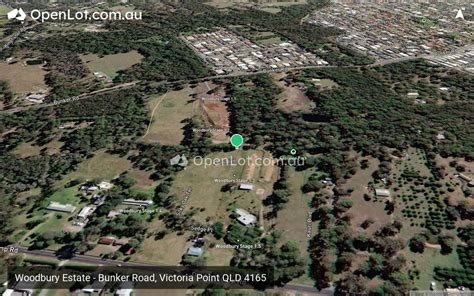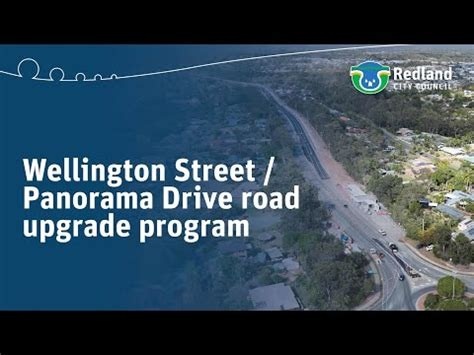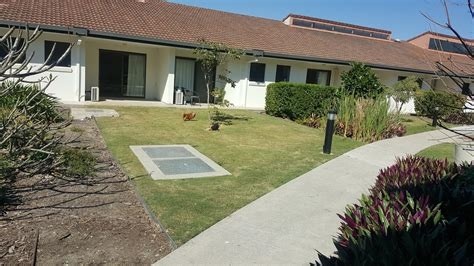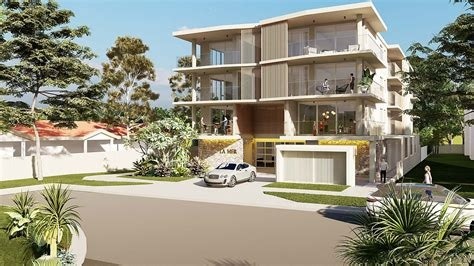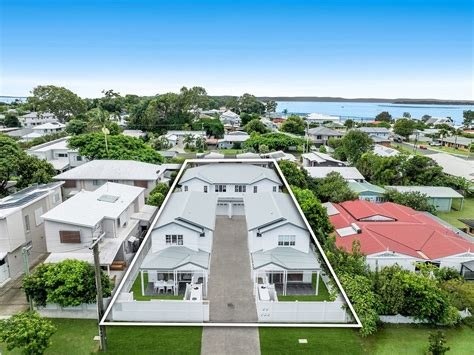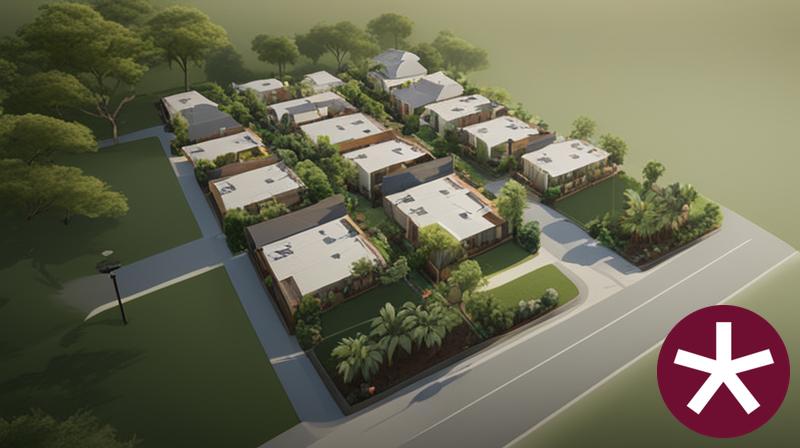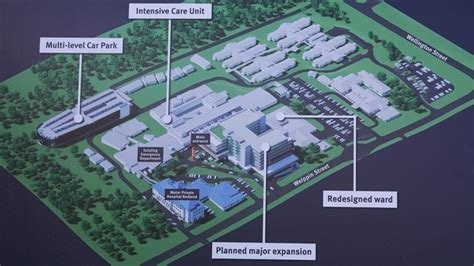Chart Color Schemes
est. as @ -- *
ABS ERP | -- people | --
2021 Census | -- people
Sales Activity
Curious about local property values? Filter the chart to assess the volume and appreciation (including resales) trends and regional comparisons, or scroll to the map below view this information at an individual property level.
Find a Recent Sale
Sales Detail
Population
Victoria Point is positioned among the lower quartile of areas assessed nationally for population growth based on AreaSearch's assessment of recent, and medium term trends
Victoria Point's population, as of August 2025, is approximately 16,023. This figure represents a growth of 883 people since the 2021 Census, which recorded a population of 15,140. The increase is inferred from the estimated resident population of 15,871 in June 2024 and an additional 520 validated new addresses since the Census date. This results in a density ratio of 1,194 persons per square kilometer, comparable to averages observed across other locations assessed by AreaSearch. Victoria Point's growth rate of 5.8% since the census is within 1.8 percentage points of the SA4 region (7.6%), indicating competitive growth trends. Interstate migration contributed approximately 58.4% of overall population gains during recent periods.
AreaSearch uses ABS/Geoscience Australia projections for each SA2 area, released in 2024 with a base year of 2022. For areas not covered by this data and years post-2032, Queensland State Government's SA2 area projections are adopted, released in 2023 and based on 2021 data. However, these state projections do not provide age category splits; hence proportional growth weightings aligned with ABS Greater Capital Region projections (released in 2023, based on 2022 data) for each age cohort are applied where utilized. Considering projected demographic shifts, the area's population is expected to decrease by 255 persons by 2041. However, specific age cohorts are anticipated to grow, notably the 85 and over age group, which is projected to increase by 885 people.
Frequently Asked Questions - Population
Development
AreaSearch assessment of residential development activity positions Victoria Point among the top 25% of areas assessed nationwide
Victoria Point has seen approximately 47 new homes approved annually. The Australian Bureau of Statistics produces development approval data on a financial year basis, totalling 237 approvals from FY-20 to FY-25 and 41 so far in FY-26. On average, about 0.6 people have moved to the area for each dwelling built over these five years, indicating that supply is meeting or exceeding demand. This supports buyer choice and potential population growth.
The average construction cost value of new properties is $469,000. In FY-26, $15.3 million in commercial development approvals have been recorded, showing steady commercial investment activity. Compared to Greater Brisbane, Victoria Point has 18.0% lower construction activity per person but ranks among the 90th percentile nationally, with recent intensification of building activity.
New building activity comprises 76.0% detached houses and 24.0% attached dwellings, preserving the area's suburban nature while attracting space-seeking buyers. With around 79 people per approval, Victoria Point reflects a low-density area. Population projections indicate stability or decline, which should reduce housing demand pressures and benefit potential buyers.
Frequently Asked Questions - Development
Infrastructure
Victoria Point has emerging levels of nearby infrastructure activity, ranking in the 24thth percentile nationally
Changes to local infrastructure significantly impact an area's performance. AreaSearch identified 13 projects likely influencing the region. Notable ones are Woodbury Estate at Victoria Point, Arc on the Point - Clay Gully Development, South West Victoria Point Local Plan, and La Mer Thompson's Beach. The following details those most relevant.
Professional plan users can use the search below to filter and access additional projects.
INFRASTRUCTURE SEARCH
Frequently Asked Questions - Infrastructure
Redlands Satellite Health Centre (Talwalpin Milbul)
The Redlands Satellite Health Centre, co-named Talwalpin Milbul meaning 'Redland Bay Alive/Active' in Jandai language, provides walk-in care for minor injuries and illnesses, specialist outpatient services including renal dialysis and cancer day therapy, diagnostic facilities. It operates from 8am to 10pm daily, serving the Redlands Coast and Bay Islands communities. Opened on 28 August 2023 and renamed from Satellite Hospital to Health Centre in March 2025 to clarify services.
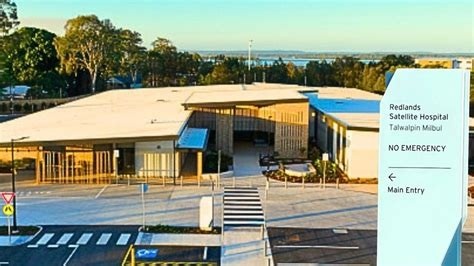
Southern Thornlands Priority Development Area
890-hectare Priority Development Area declared on 4 April 2025 to provide approximately 8,000 new dwellings and accommodate up to 20,000 residents. Includes mixed-use centres, employment areas, infrastructure, and environmental corridors with Interim Land Use Plan in effect. Recognised as a priority future growth area in Shaping SEQ 2023, supporting regional growth with diverse housing including social and affordable housing, business and industrial zones, activity centres for local job creation, and integrated infrastructure planning covering transport, education, community facilities, stormwater management, and parks.
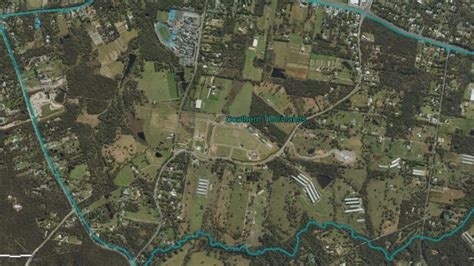
Southern Thornlands Priority Development Area
The Southern Thornlands PDA was officially declared on 4 April 2025, covering 890 hectares to deliver around 8,000 new dwellings and accommodate approximately 20,000 new residents. The project includes an integrated approach to infrastructure planning with transport, education, community facilities, stormwater management, and parks. An Early Release Area allows for 900 homes initially, with up to 20% affordable and social housing. The development will create new employment areas with business and industrial zones alongside activity centres.
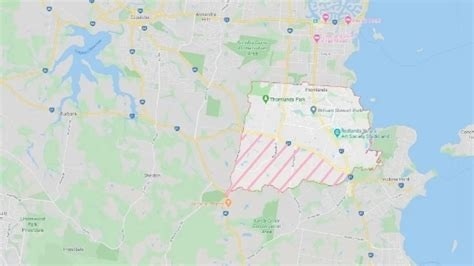
South West Victoria Point Local Plan
Local plan guiding an emerging community in southwest Victoria Point. Following Planning and Environment Court approvals in 2021, Council indicates the local plan will be incorporated into the next City Plan review (targeted by 2028). Enabling infrastructure works include a funded central sewer trunk expansion to service the Double Jump Rd precinct.
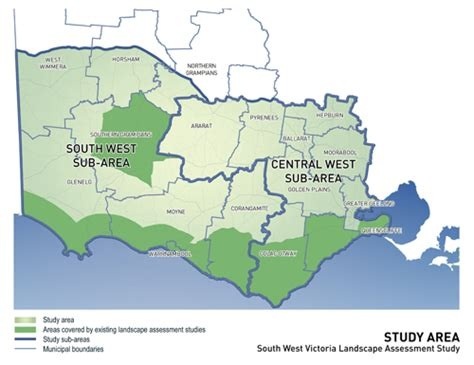
Weinam Creek Priority Development Area
A 42-hectare waterfront redevelopment transforming Weinam Creek into a vibrant transport hub and gateway to Southern Moreton Bay Islands. Includes multi-storey car parks with over 2200 spaces, enhanced ferry terminal, retail precinct, restaurants, cafes, recreational facilities, improved marina, commercial marine services, and boosted ferry services. Consolidated Properties Group is the preferred partner for the car park and retail, delivering over $100 million in infrastructure. Managed by Redland Investment Corporation, focusing on marine industry and boating. Includes land swap for satellite hospital site.
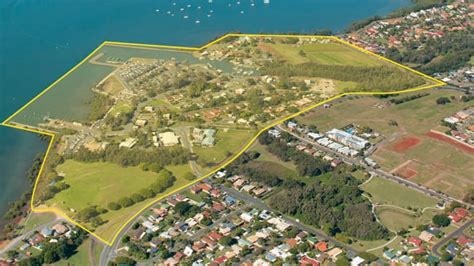
Paradise Garden Shopping Village
A completed Coles-anchored neighbourhood shopping centre with 8,000sqm GFA featuring specialty stores, dining options, medical facilities, BP service station, and 1.4 hectares of green space parkland, serving as a thriving community retail and leisure hub that officially opened May 3, 2024.
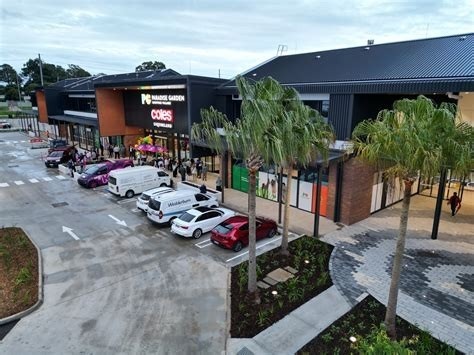
Cleveland-Redland Bay Road Duplication
A $110 million road infrastructure project duplicating Cleveland-Redland Bay Road from two to four lanes between Anita Street and Magnolia Parade. Includes intersection upgrades, new pedestrian and cycling infrastructure, improved safety features, noise barriers, and koala fencing to reduce congestion and enhance connectivity. Construction is underway with completion expected by 2026.
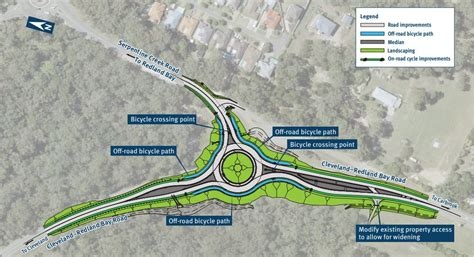
Arc on the Point - Clay Gully Development
A $92 million residential project featuring 261 lots on a 20.6 hectare site near Clay Gully Road. Average block size for stage one is 424 square metres. Developed by Urbex, a wholly owned subsidiary of BMD Group since 2003. Open space, parkland and conservation areas make up over 23% of the site with Arc Boulevard Park (7,000m2), playground, picnic areas, bike and walking trails.
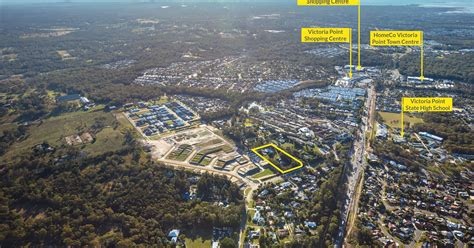
Employment
Employment performance in Victoria Point exceeds national averages across key labour market indicators
Victoria Point has a skilled workforce with essential services sectors well represented. Its unemployment rate is 3.0% and it saw estimated employment growth of 4.9% in the past year.
As of June 2025, 7,911 residents are employed while the unemployment rate is 1.1% lower than Greater Brisbane's rate of 4.1%. Workforce participation lags at 55.0%, compared to Greater Brisbane's 64.5%. Leading industries include health care & social assistance, construction, and retail trade. Construction has a particularly strong presence with an employment share 1.5 times the regional level.
Professional & technical services have limited representation with 5.8% employment compared to 8.9% regionally. The area appears to offer limited local employment opportunities. Over the year to June 2025, employment increased by 4.9% and labour force by 4.3%, reducing the unemployment rate by 0.5 percentage points. Greater Brisbane saw employment growth of 4.4% with a 0.4 percentage point drop in unemployment. State-level data to Sep-25 shows Queensland employment contracted by 0.23% while its unemployment rate is 4.2%. National comparisons show QLD lagging national employment growth of 0.26% and having an unemployment rate of 4.5%. Jobs and Skills Australia forecasts national employment growth of 6.6% over five years and 13.7% over ten years. Applying these projections to Victoria Point's mix suggests local growth of approximately 6.4%% over five years and 13.3% over ten years.
Frequently Asked Questions - Employment
Income
The area's income profile falls below national averages based on AreaSearch analysis
AreaSearch's latest postcode level ATO data for financial year 2022 shows that Victoria Point has an income below the national average. The median assessed income is $50,093 and the average income stands at $60,115. This contrasts with Greater Brisbane's figures of a median income of $55,645 and an average income of $70,520. Based on Wage Price Index growth of 11.71% since financial year 2022, current estimates for Victoria Point would be approximately $55,959 (median) and $67,154 (average) as of March 2025. According to Census 2021 income data, household, family, and personal incomes in Victoria Point all rank modestly, between the 29th and 36th percentiles. Income distribution shows that 30.3% of locals (4,854 people) fall into the $1,500 - 2,999 category, reflecting patterns seen in the metropolitan region where 33.3% similarly occupy this range. Housing affordability pressures are severe in Victoria Point, with only 82.2% of income remaining, ranking at the 35th percentile. The area's SEIFA income ranking places it in the 5th decile.
Frequently Asked Questions - Income
Housing
Victoria Point is characterized by a predominantly suburban housing profile, with above-average rates of outright home ownership
Victoria Point's dwellings, as recorded in the latest Census, consisted of 80.9% houses and 19.2% other dwellings (semi-detached, apartments, 'other' dwellings). Brisbane metro had a slightly higher proportion of houses at 83.9%, with 16.1% being other dwellings. Home ownership in Victoria Point stood at 40.4%, which was higher than Brisbane metro's level. The remaining dwellings were either mortgaged (37.4%) or rented (22.2%). The median monthly mortgage repayment in Victoria Point was $1,950, lower than the Brisbane metro average of $2,000. The median weekly rent figure for Victoria Point was $450, higher than Brisbane metro's $425. Nationally, Victoria Point's median monthly mortgage repayments were higher at $1,950 compared to Australia's average of $1,863, while rents were substantially higher at $450 compared to the national figure of $375.
Frequently Asked Questions - Housing
Household Composition
Victoria Point has a typical household mix, with a lower-than-average median household size
Family households constitute 73.4% of all households, including 28.9% couples with children, 33.4% couples without children, and 10.3% single parent families. Non-family households account for the remaining 26.6%, with lone person households at 24.6% and group households comprising 2.0%. The median household size is 2.5 people, which is smaller than the Greater Brisbane average of 2.6.
Frequently Asked Questions - Households
Local Schools & Education
Victoria Point shows below-average educational performance compared to national benchmarks, though pockets of achievement exist
The area faces educational challenges, with university qualification rates at 17.5%, significantly lower than the Greater Brisbane average of 30.5%. This presents both a challenge and an opportunity for targeted educational initiatives. Bachelor degrees are the most prevalent at 12.4%, followed by postgraduate qualifications (2.8%) and graduate diplomas (2.3%). Trade and technical skills are prominent, with 41.8% of residents aged 15+ holding vocational credentials – advanced diplomas at 12.5% and certificates at 29.3%.
A substantial 23.8% of the population is actively pursuing formal education, including 8.2% in primary education, 7.6% in secondary education, and 3.3% pursuing tertiary education. There are six schools operating within Victoria Point, educating approximately 3006 students, while Victoria Point demonstrates typical Australian school conditions (ICSEA: 1009) with balanced educational opportunities. Educational provision is split between three primary and three secondary institutions. School capacity exceeds typical residential needs at 18.8 places per 100 residents compared to the regional average of 14.4, indicating that the area serves as an educational center for the broader region.
Frequently Asked Questions - Education
Schools Detail
Nearby Services & Amenities
Transport
Transport servicing is moderate compared to other areas nationally based on assessment of service frequency, route connectivity and accessibility
Victoria Point has 70 active public transport stops, all of which are bus stops. There are 11 different bus routes serving these stops, collectively providing 1,498 weekly passenger trips. The average distance from residents to the nearest transport stop is 237 meters, indicating good accessibility.
On average, there are 214 bus trips per day across all routes, resulting in about 21 weekly trips per individual stop.
Frequently Asked Questions - Transport
Transport Stops Detail
Health
Health performance in Victoria Point is well below average with prevalence of common health conditions notable across both younger and older age cohorts
Victoria Point faces significant health challenges, with common conditions prevalent across both younger and older age groups. Approximately 50% of its total population (~7,931 people) has private health cover, compared to Greater Brisbane's 54.2% and the national average of 55.3%. The most common medical conditions are arthritis (affecting 11.0%) and mental health issues (8.6%), with 60.7% reporting no medical ailments, compared to Greater Brisbane's 64.6%.
As of October 2021, Victoria Point has a higher proportion of seniors aged 65 and over at 31.5% (~5,053 people) than Greater Brisbane's 25.3%. Senior health outcomes align with the general population's profile, indicating some challenges in this demographic.
Frequently Asked Questions - Health
Cultural Diversity
Victoria Point ranks below the Australian average when compared to other local markets across a number of language and cultural background related metrics
Victoria Point's cultural diversity was below average, with 77.6% born in Australia, 90.4% being citizens, and 94.8% speaking English only at home. Christianity dominated Victoria Point's religious landscape at 56.5%, compared to Greater Brisbane's 52.8%. The top three ancestry groups were English (34.3%), Australian (26.3%), and Scottish (9.1%).
Notably, New Zealanders were overrepresented at 1.3% versus 1.2% regionally, South Africans at 0.8% versus 1.0%, and Maori at 0.9% compared to the same regional figure.
Frequently Asked Questions - Diversity
Age
Victoria Point hosts an older demographic, ranking in the top quartile nationwide
Victoria Point's median age is 49 years, which is significantly higher than Greater Brisbane's average of 36 years and Australia's national median age of 38 years. The age profile shows that those aged 75-84 are particularly prominent, making up 12.6% of the population, while those aged 25-34 make up a smaller proportion at 6.8%. This concentration of people aged 75-84 is well above the national average of 6.0%. Since 2021, the percentage of people aged 75 to 84 has grown from 10.5% to 12.6%, while those aged 25 to 34 have declined from 8.1% to 6.8%. The 45-54 age group has also decreased, from 13.3% to 12.0%. By 2041, population forecasts indicate substantial demographic changes for Victoria Point. The 85+ cohort is projected to grow by 97%, adding 840 residents to reach a total of 1,706. Senior residents aged 65 and above will drive all the population growth, highlighting demographic aging trends. Conversely, population declines are projected for those aged 55-64 and 45-54.
